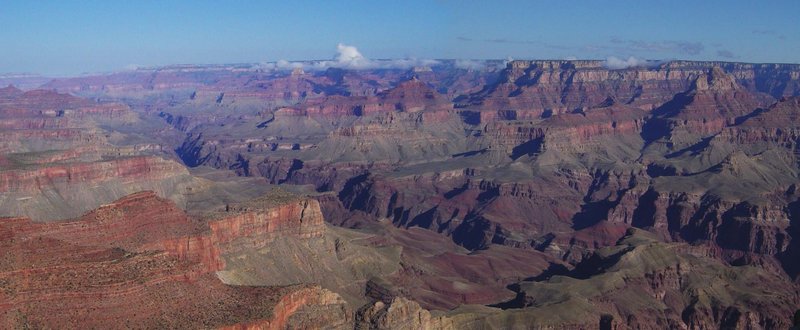I see what you mean, but I still have to disagree with you. I don't think that the geologic column holds the appearance of a worldwide flood. If we look at sedimentary rock, we see that there is not one layer, but there are countless ones. Certain organisms are found only in specific layers - for example, we don't find trilobites in the same layers we find fish. The strata does not appear to me to have been formed in a single event.
Let's look at the Grand Canyon. I got this picture from the Wikipedia article on the Grand Canyon, and you can find a higher resolution version there.
 Full Scale Photo{Changed photo scale to "100%", to restore page width to normal, and added link to full size version. - Adminnemooseus}
Full Scale Photo{Changed photo scale to "100%", to restore page width to normal, and added link to full size version. - Adminnemooseus}
In this image, there are many visible layers. I feel it is reasonable to assume that they were not all laid down at the same time, or even in quick succession, because each one appears to be made from different types of rock. For example, at the bottom of the canyon, metamorphic rock about 1.6 to 2 billion years old is exposed. This contains no fossils, but it holds evidence of volcanic and tectonic activity. Plutons, objects formed from magma which has hardened underground, have been found in this lower layer, as well as layers of volcanic ash and dust indicating eruptions when this part was at the surface. The plutons were likely formed when this part was pulled underground by tectonic activity.
Higher layers, of about 800 million to 1.2 billion years of age, show different types of rock with evidence of sedimentation. One part is called the Unkar group, and it contains several related layers. The lowest is a layer of limestone which contains stromatolite fossils, signifying life in a marine environment. I don’t see any way that could have formed from a single event that lasted only a couple months. Above this layer, there is evidence that the water receded for some time, forming a layer of shale from clay and mud. Further up, we see a layer of quartzite, which was once sandstone, and then a layer of sandstone and shale, and then a thick layer of lava, which appears to have eroded somewhat before being covered up by even more sedimentation.
At this point, I see no evidence of a global flood. There is evidence at this point of flooding of the area, and of shorelines and shallow seas which eroded and changed that area greatly, but this does not match up with other parts of the world, which do not possess the same types of sedimentation, as would be expected in a global flood.
Higher up, there is a layer about 550 millions years old with various fossils of animals such as trilobites, brachiopods, and burrowing worms. If there had been a global flood, I feel that at least a few of these would be found mixed up with the stromatolites in the Unkar group. Newer layers show fossils of crinoids, brachiopods, sponges, and corals, but these are separate from other layers containing lots of plants and amphibian fossils. These could not have lived at the same time, since the crinoids and corals are more likely to have lived in deeper water than the plants and amphibians, in much the same way we do not see frogs living in the middle of the ocean today, or corals living in freshwater streams.
In summary, in the Grand Canyon we can find numerous layers of rock, each of which formed under its own conditions. For example, we can find rocks formed at least in part by sedimentation that are covered with a layer of igneous rock which could only have formed from lava. We also see fossils in higher layers that could not have lived alongside the creatures in the lower layers. The flood as described in the Bible is unlikely to have produced any of these formations. It is extremely unlikely that such a flood would have deposited separate layers of different types of sediment — clay and sand separately, forming shale and sandstone, for example, and it is unlikely to have produced the separations we see in the organisms found in the fossils of the Grand Canyon.
This message has been edited by Adminnemooseus, 02-20-2005 01:25 AM


 ™ Version 4.2
™ Version 4.2